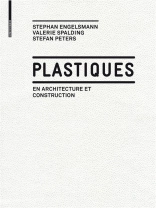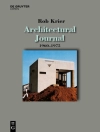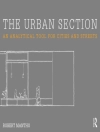Plastics are high-performance materials of wide use in the built environment. Their versatile technical properties are particularly fascinating. A broad range of form-giving and finishing processes makes plastic especially interesting for complex geometries in combination with digital planning processes. Following the pioneering plastic structures of the 1970s, a number of spectacular buildings have in recent years highlighted the outstanding technical and aesthetic potential of the material.
Until now, however, there has been no systematic treatment of the use of plastic in architecture. This book seeks to fill that gap by providing an introduction to the structural and design possibilities of plastic. It introduces the material and its specific characteristics, describes various types of plastic in terms of their relevance for building, explains processing technologies and presents typical products and components. A concise presentation of twenty-five international built projects – organized by the type of application and the plastic involved – documents the broad range of plastic in architecture. Finally, a look ahead at the future describes the current state of the art in materials research.
Table des matières
Préface
1 Vers l’architecture en plastique
Les Principes
2 Propriétés des matériaux
Malléabilité et fabrication des pièces
Résistance aux intempéries
Propriétés thermiques
Combustibilité et inflammabilité
Additifs, charges et agents renforçants
3 Connaissance des matériaux
Structures des polymères
Morphologie des macromolécules
Classification des plastiques selon leux taux de réticulation
Procédés de synthèse
4 Types de plastiques et fabrication
Élastomères
Thermoplastiques
Matériaux
Fabrication
Façonnage
Recyclage
Thermodurcissables
Composant des matériaux
Fabrication
Propriétés
La Construction
5 Semi-produits et produits finis
Plaques monolithiques
Plaques profilées
Panneaux sandwich
Mousses
Profilés
Produits spéciaux
6 Construire avec les plastiques
Thermoplastiques
Vissage
Encliquetage
Collage
Soudage
Thermodurcissables
Vissage
Collage
Dimensionnement
Résistance et durabilité
Exemples et projets
7 Le plastique en fonction enveloppante
Chanel Mobile Art Pavilion, Hongkong, Chine; Tokyo, Japon; New York, États-Unis
BMW Bubble, Francfort et Berlin, Allemagne
Kunsthaus Graz, Graz, Autriche
Gare ferroviaire d’Emsdetten, Emsdetten, Allemagne
Idee Workstation, Tokyo, Japon
Reiss Headquarters, Londres, Grande-Bretagne
Bâtiment administratif et de production de Fiberline, Middelfart, Danemark
Farben des Konsums, Berlin, Allemagne
Laban Creekside, Londres, Grande-Bretagne
Terminal V, Lauterach, Autriche
Forum Soft, Yverdon, Suisse
Polymer Engineering Centre, Melbourne, Australie
Le Musée Dornier, Friedrichshafen, Allemagne
Centre de conférences et auditorium, Badajoz, Espagne
8 Le plastique en fonction porteuse
Sculpture-tour en plastique
Stuttgart, Allemagne
D-tour, Doetinchem, Pays-Bas
Ârret de bus de Hoofddorp, Hoofddorp, Pays-Bas
Toiture du centre Yitzhak Rabin, Tel Aviv, Israël
Pavillon Verre/GFK, Düsseldorf, Allemagne
Structure en plastique plissé, Stuttgart, Allemagne
9 Le plastique en fonction porteuse et enveloppante
Clip-On, Utrecht, Pays-Bas
Eiertempel, Berne, Suisse
Cinq Bulles, Vienne, Autriche
fg 2000, Altenstadt, Allemagne
Futuro, divers lieux dans le monde
MYKO, Weimar et Rostock, Allemagne
Bâtiment de réception de Novartis Campus, Bâle, Suisse
10 Perspectives de développement
Matériaux ultraperformants pour structures porteuses
Matériaux ultraperformants pour enveloppes de bâtiment
Combinaison de plusieurs matériaux
Renforcement a posteriori des structures porteuses
Techniques d’assemblage adaptées aux matériaux
Nouveaux modes de production
Transfert de technologies
Glossaire
Bibliographie
Les auteurs
Remerciements
Index des noms et de bâtiments
Index de sujets
Crédits des illustrations
A propos de l’auteur
Prof. Dr.-Ing. Stephan Engelsmann ist Bauingenieur. Er studierte Bauingenieurwesen an der TU München und Architektur an der University of Bath. Er war wissenschaftlicher Mitarbeiter bei Jörg Schlaich und arbeitete in verschiedenen Ingenieurbüros. Er ist heute Professor für konstruktives Entwerfen und Tragwerkslehre an der Staatlichen Akademie der Bildenden Künste Stuttgart und er ist Gründungspartner im Ingenieurbüro Engelsmann Peters Beratende Ingenieure in Stuttgart.
Valerie Spalding studierte Architektur an der RWTH Aachen. Sie arbeitete in verschiedenen Architekturbüros im In- und Ausland, darunter James Carpenter Design Associates in New York. Seit 2005 ist sie wissenschaftliche Mitarbeiterin an der Staatlichen Akademie der Bildenden Künste Stuttgart und forscht zum Thema Bauen mit Kunststoffen.
Dr.-Ing. Stefan Peters ist Bauingenieur. Er studierte an der Universität Stuttgart und war Mitarbeiter in verschiedenen Ingenieurbüros, unter anderem Werner Sobek Ingenieure. Nach einer Tätigkeit als wissenschaftlicher Mitarbeiter an der Universität Stuttgart bei Jan Knippers von 2000 bis 2006 gründete er mit Stephan Engelsmann das Ingenieurbüro Engelsmann Peters Beratende Ingenieure in Stuttgart.












